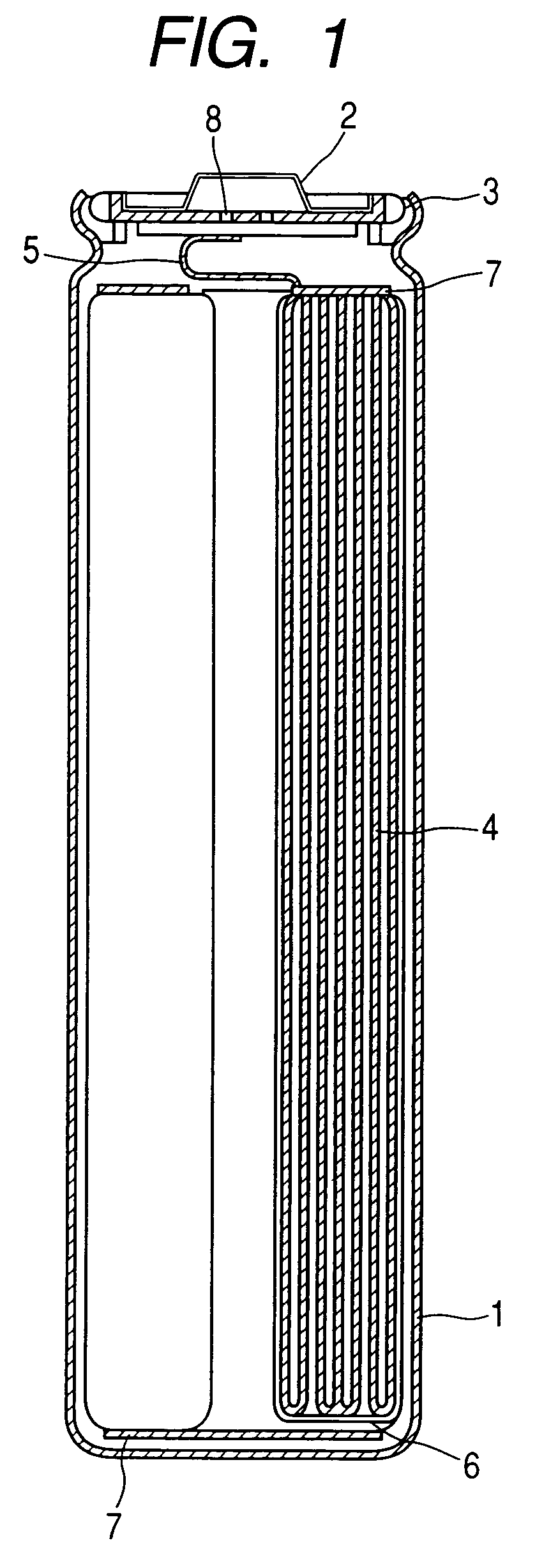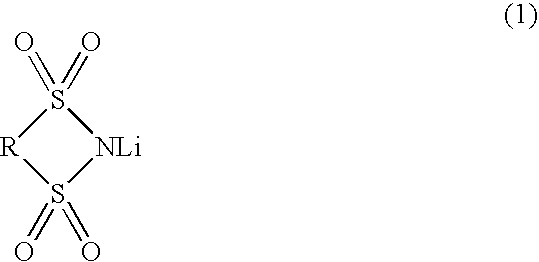Nonaqueous electrolytic solution and lithium secondary battery
a technology of nonaqueous electrolysis and lithium secondary batteries, which is applied in the direction of non-aqueous electrolyte cells, cell components, electrochemical generators, etc., can solve the problems of increasing the capacity of the battery, deteriorating battery characteristics, and expanding or breaking the battery in severe cases, so as to improve the cycle characteristics, facilitate the formation of a stable film excellent in the permeability of lithium ions, and suppress the reactivity of the positive electrode
- Summary
- Abstract
- Description
- Claims
- Application Information
AI Technical Summary
Benefits of technology
Problems solved by technology
Method used
Image
Examples
example 1
[0106]Under an argon dry atmosphere, 2 parts by weight of vinylene carbonate was added to 98 parts by weight of a mixture of ethylene carbonate, ethylmethyl carbonate, dimethyl carbonate and diethyl carbonate (volume ratio: 2 / 4 / 2 / 2), in which LiPF6 and LiBF4, which had been sufficiently dried, were dissolved to make ratios of 1.0 mole / L and 0.05 mole / L, respectively, to produce an electrolytic solution.
[0107]A cylindrical lithium secondary battery was produced by using the electrolytic solution thus obtained, and evaluated for the characteristics after continuous charging and the cycle characteristics. The results are shown in Table 1.
example 2
[0108]2 parts by weight of vinylene carbonate was added to 98 parts by weight of a mixture of ethylene carbonate and ethylmethyl carbonate (volume ratio: 2 / 8), in which LiPF6 and LiBF4, which had been sufficiently dried, were dissolved to make ratios of 1.0 mole / L and 0.05 mole / L, respectively, to produce an electrolytic solution.
[0109]A cylindrical lithium secondary battery was produced by using the electrolytic solution thus obtained, and evaluated for the characteristics after continuous charging and the cycle characteristics. The results are shown in Table 1.
example 3
[0110]2 parts by weight of vinylene carbonate was added to 98 parts by weight of a mixture of ethylene carbonate and diethyl carbonate (volume ratio: 2 / 8), in which LiPF6 and LiBF4, which had been sufficiently dried, were dissolved to make ratios of 1.0 mole / L and 0.05 mole / L, respectively, to produce an electrolytic solution.
[0111]A cylindrical lithium secondary battery was produced by using the electrolytic solution thus obtained, and evaluated for the characteristics after continuous charging and the cycle characteristics. The results are shown in Table 1.
PUM
| Property | Measurement | Unit |
|---|---|---|
| molar ratio | aaaaa | aaaaa |
| temperature | aaaaa | aaaaa |
| melting point | aaaaa | aaaaa |
Abstract
Description
Claims
Application Information
 Login to View More
Login to View More - R&D
- Intellectual Property
- Life Sciences
- Materials
- Tech Scout
- Unparalleled Data Quality
- Higher Quality Content
- 60% Fewer Hallucinations
Browse by: Latest US Patents, China's latest patents, Technical Efficacy Thesaurus, Application Domain, Technology Topic, Popular Technical Reports.
© 2025 PatSnap. All rights reserved.Legal|Privacy policy|Modern Slavery Act Transparency Statement|Sitemap|About US| Contact US: help@patsnap.com



